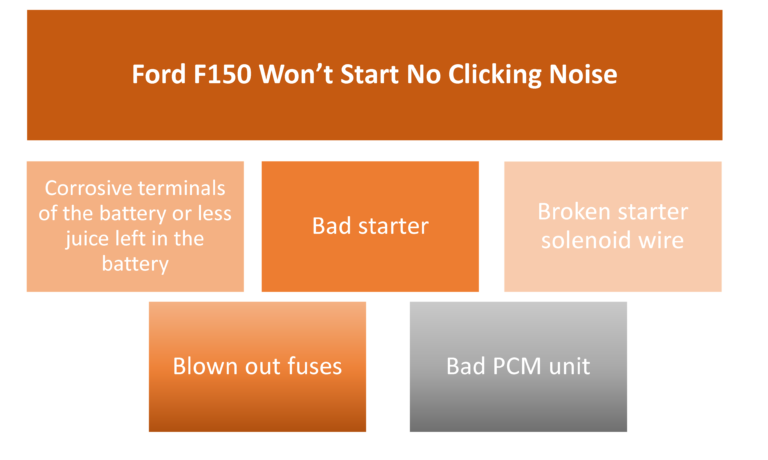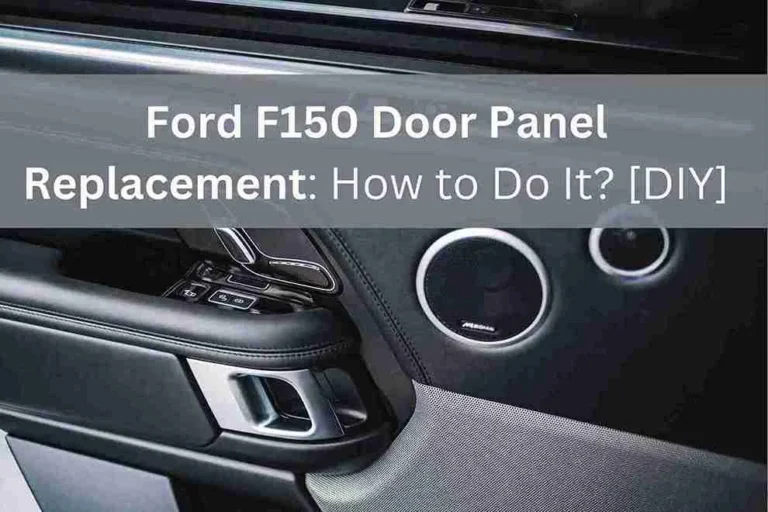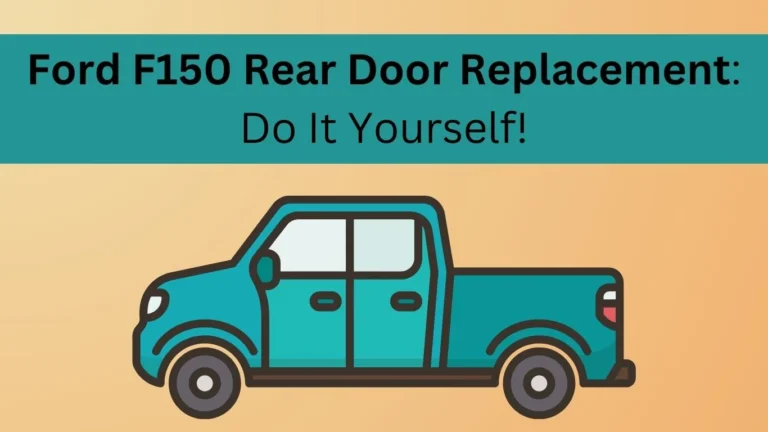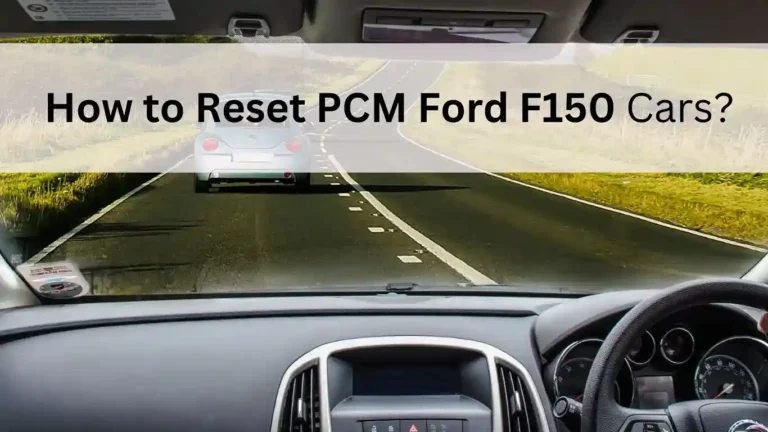It can get frustrating when your Ford F150 wont start with no clicking noise as you try to turn the key.
Usually, you’ll find the Ford F150 not starting without any click noise if the battery terminals are rusty. It can also happen from issues with power loss, starter, and its solenoid wire, or PCM unit. Melted or damaged fuses can cause this problem too.
In this guide, I’ll help you identify the causes and suggest solutions. Hopefully, this will help you understand why it’s happening and how to fix it right away. Let’s get started!
Table of Contents
Reasons Ford F150 Wont Start No Clicking Noise
There are many reasons why the Ford F150 might not start and make no clicking sound. I’ve picked a few possible causes and solutions for you to try. But first, let me show you a simple table that explains it all:
| Causes | Repairs |
| Corrosive terminals of the battery or less juice left in the battery | Lubricate the terminals or replace the battery |
| Bad starter | Change the starter |
| Broken starter solenoid wire | Repair the starter solenoid wire |
| Blown out fuses | Replace the fuses |
| Bad PCM unit | Change the PCM unit |
1. Battery Power Not Going to the Starter
In most cases, your new or old (1993 – 2012) Ford F150 won’t start with no clicking noise when the starter doesn’t get power from the battery.
This happens as the battery lacks the juice to send proper power to the starter or the terminals are rusty. To fix it, you’ll need to clean the corrosion from the terminals or change the 12V battery.
Coggin Denald Ford highlighted common signs of requiring a F-150 battery replacement: slow start after turning the key, corroded cables/connectors, clicking sound when turning the key, and functional electronics with a non-starting car.
How to Resolve?
After opening the hood of your F150, find the battery and take out the nut from the black (-) terminal with the help of a ratchet wrench. Then, do the same thing to detach the nut from the red (+) terminal of the battery.
Next, grab the battery cleaner or lubricant to soak the rust from the terminals (that seems terrible). Be sure to wait for a while before you put them back on.
If this doesn’t fix the issue, you’ll need to remove the nuts that carry the battery inside. Afterward, take out the black (-) terminal’s nut before removing the red (+) terminal’s nut with the socket wrench.
Now, detach the old battery and put on a new one. Then, reinstall all the removed parts. Be sure to check this guide to know the solutions if your F150 doesn’t start after replacing the battery.
Repair Cost: $350 – $410 ($250 or more for parts and the rest for labor).
Duration: 30 minutes.
2. Faulty Starter
If your old or new (2000 – 2013) Ford F150 won’t start with no clicking noise when you twist the key, it can happen due to a bad starter part.
As the part is faulty, it fails to receive the battery power through the wire and fuse. This is also a common cause behind a f150 turning over but failing to start. In that case, you’ll need to insert a new starter in the old spot.
How to Resolve?
You can start the process by detaching the negative terminal of the battery inside the hood and placing a towel to avoid electrical interference.
Next, insert the jack pads on the four corners and attach the stands to lift the car up. After that, locate the starter part underneath the car’s passenger side on the transmission bell housing.
Then, you’ll need to grab a 13mm socket to detach the 4 nuts and then detach the 4 wires. Afterward, use the socket wrench with a 6” extender to easily remove the bolts on the other side of the starter.
Now, you can remove the starter part with a little bang of the hammer. Then, insert the new starter and put the bolts in the proper spots. After that, reinstall all the removed parts.
To understand the process better, you can check out this video that explains the procedure in detail. Here’s the video guide!
Repair Cost: $350 – $400 or more ($250 or more for parts and the rest for labor).
Duration: 50 minutes.
3. Broken Starter Solenoid Wire
Sometimes the starter solenoid wire that goes to the battery terminal can break apart and cause the car to not start or crank at all. To fix it, you’ll need to check the wire condition and then patch it up.
How to Resolve?
Start by opening the hood of your F150 and then detach the black negative (-) terminal of the battery. Then, locate the starter solenoid wire that goes to the battery.
To reach out the starter solenoid properly, you’ll need to put on the jack pads and stands to lift the car. Then, get under the car and find the starter solenoid part in the transmission bell housing on the car’s passenger side.
Afterward, take a 13mm socket and detach the nut that holds the big wire that comes from the battery. Then, track the wire and simply pull it out before you replace it. Lastly, reinstall all the parts.
Repair Cost: $250 or more ($50 or more for parts and the rest for labor).
Duration: 30 – 60 minutes.
4. Faulty Fuses
Mostly, the new or old (1999 – 2018) Ford F150 won’t start no clicking noise issue occurs when the fuses are blown out. You see, the ignition switch feed and starter relay fuses can melt due to intense electrical interaction.
These two parts are responsible for starting the car with a clicking noise. You’ll simply need to change these fuses to make it work again.
How to Resolve?
To begin with, open the hood of your F150 and locate the engine compartment fuse box to open the lid. Then, find the ignition switch feed and starter relay fuses inside based on the fuse number on your car’s owner manual.
The starter relay fuse is 30A in all-year F150 cars while the ignition switch fuse can vary based on year. For example, it’s 20A, 10A, or 5A on F150 cars based on the year.
After finding the fuses in the fuse box, inspect them and then replace both. Then, reinstall the lid of the fuse box and close the hood before you test it out.
Repair Cost: $100 or more ($10 or more for parts and the rest for labor)
Duration: 10 minutes.
5. Dead PCM Unit
When the car’s PCM unit fails to operate, it can cause your F150 to not start or make a cranking sound when you twist the key. Further damage to the PCM Unit can also result in intermittent starting issues in the f150. To repair it, you’ll need to change the PCM aka Power Control Module part inside the hood.
How to Resolve?
To start with, you’ll need to get a new PCM unit from a nearby store and then open the hood of your F150 like you usually do. Afterward, locate the PCM unit in the front area (behind the passenger-side kick panel).
Now, detach the black negative (-) pole wire of the battery after loosening up the nut with a 13mm socket. Then, detach all the connectors by pulling the top part that is attached to the PCM and marking them if you don’t know which one goes where.
Next, take a 10mm socket to detach the 4 bolts that hold the unit in place. Once it’s done, remove the PCM unit and insert a new one. Then, reinstall all the parts and test them out.
Repair Cost: $700 – $900 or more ($650 or more for parts and the rest for labor)
Duration: 60 minutes.
Use A Multimeter To Check F150 Not Starting and Not Clicking Noise
Looking at the picture of the Ford F150 starting system, you can easily find out why your car won’t start and makes no clicking noise.
For that, you’ll need a multimeter to check the wires that are connected to the battery. This will help you see if the starter is getting power from the battery or not.
If there’s no power coming from the battery, you should check if there’s rust on the terminators or if the battery needs to be replaced. Based on the issue, take action to repair the bug.
Once you’ve checked that, you’ll need to test the wire that goes to the starter and starter solenoid. This will tell you if it’s getting power when you turn the car key.

If power is going to both the starter and solenoid signal, it means the starter is broken. But if there’s no power going to either of them, it means there’s a problem with the wires that bring power from the battery. In that case, you’ll need to replace the solenoid trigger wire.
And, if you hear a clicking sound from the starter relay, it means the relay is sending power to the starter solenoid trigger wire. But if the fuses are blown, it can also prevent your car from starting and making a clicking noise. In that situation, you’ll need to replace the fuses.
If everything else seems okay, it might be a problem with the PCM unit. You should check the PCM part and replace it if this is the culprit.
Ending Notes
If your Ford F150 doesn’t start without any clicking noise next time, use the solutions mentioned above to fix it quickly.
There can be many reasons for this problem, so be careful when trying these fixes. If they seem too difficult, ask an expert from a nearby auto shop for help.
I hope this informative guide helps you quickly solve the issue. I’ll be back with more guides soon. Goodbye!




